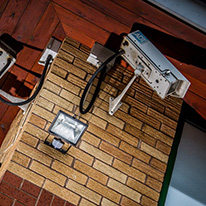 Although people often associate more megapixels with enhanced quality, this is not always the case.
Although people often associate more megapixels with enhanced quality, this is not always the case.
Megapixel image quality also depends on the conditions in which cameras are used. For example, if placed in low- or high-contrast environments, image quality may be compromised. It is important to look beyond megapixel specifications to ensure the camera will function as intended.
Megapixel cameras also require more bandwidth and storage, so selecting the best resolution for each scene becomes important to balance overall system performance – especially in multi-camera installations.
Clearly, more megapixels are not always better. For proper camera selection, start first with an assessment of your business’ security needs.
- How many surveillance cameras will I need?
- Where will my cameras be placed throughout my business?
- How many days of recorded video should be stored?
- What frame rate and resolution will be required?
- Which cameras need special capabilities like low-light or backlight performance, pan/tilt functions, or environmental ratings?
This exercise is a crucial step in selecting the appropriate mix of cameras for your business.
Megapixel Camera Advantages
When specified properly, megapixel cameras do provide increased image quality, which can deliver a range of benefits to security programs, video analytics applications, and system efficiency. Since these cameras are available in a wide range of resolutions from one to more than 30 megapixels, matching them to the application is key.
Megapixel cameras are ideal for companies that:
- Need video coverage in large areas like parking lots and warehouses. This can reduce the quantity of cameras you have to purchase, or allow the use of fixed cameras instead of pan-tilt-zoom cameras (PTZs), which are more expensive.
- Require greater detail in images for use with video analytics applications. For example, facial or license plate recognition features or point-of-sale (POS) monitoring.
- Have specific needs for forensic video quality. Megapixel cameras can be specified to ensure that an acceptable image resolution will be available for a given scene – which can greatly improve the ability to identify people and provide evidence when necessary.
Generally speaking, assess the desired images from each camera that your organization needs to achieve its surveillance goals, and then select cameras accordingly.
Balance Bandwidth and Storage Capabilities
Finally, don’t forget to consider bandwidth and video storage requirements. All things being equal, the more megapixels, the larger the recorded file size, which means more bandwidth and storage is needed. Work with your IT team to balance usability against network capacity, and to ensure the network infrastructure is in place to support your cameras. You may need to adjust the frame rate, compression, or even specify different cameras if the available bandwidth and storage are insufficient.
How does your business assess security needs and equipment capabilities? Share with us in the comments below.
Image Source: CWCS Managed Hosting